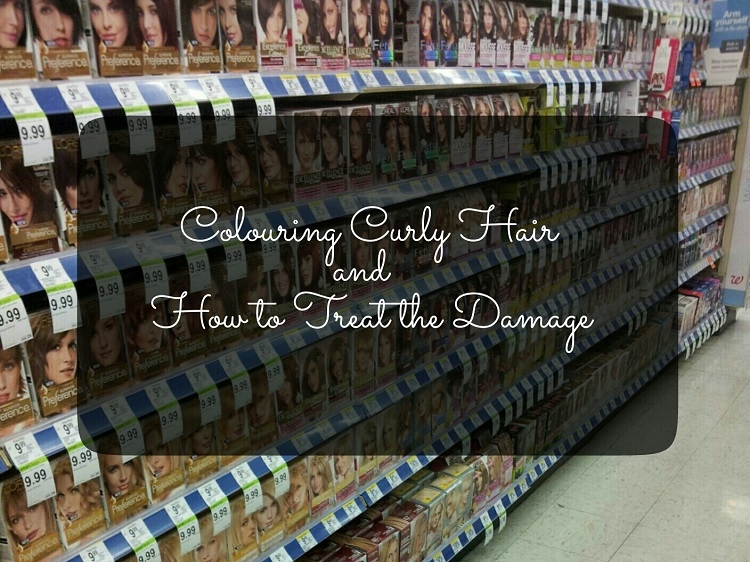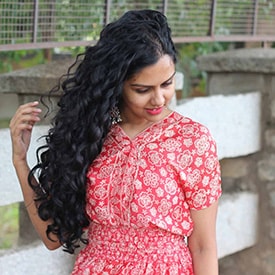
Some of you had asked me to post some tips on what to use to colour or dye curly hair and also for some tips to take care of the damage post colouring. Here goes 🙂
What type of colour to use on curly hair?
Colouring will almost always, without exception damage hair. It may make curls go straight or out of shape and wonky. It may make curls become extremely dry, frizzy and damaged. If you have an option, I would ask you not to colour your hair or at least limit it to just highlights. But some people like a change in their hair colour or they want to cover their greys.
In the decreasing order of damage (cuticle lifting), Permanent hair dyes > Demi-permanent dyes > Semi permanent dyes
Permanent hair dyes – Highest level of hydrogen peroxide and ammonia. Ammonia lifts the cuticle. Once inside the hair shaft, hydrogen peroxide first bleaches the natural colour of hair & then oxidises the dye precursors to deposit new colour. E.g.: L’Oréal Excellence Creme hair color, Garnier Color Naturals Nourishing Permanent Hair Color Cream
Demi-permanent dyes – Usually do not contain ammonia but have a milder cuticle lifting agent; and they have lower concentrations of hydrogen peroxide. So they are used only when the colour is darker to the current shade of hair. E.g.: L’Oréal Casting Creme Gloss
Semi-permanent dyes – They don’t contain ammonia or hydrogen peroxide. The colour pigments get deposited on the surface and do not penetrate the hair. This kind of depositing colour pigments on the hair and can lead to permanent curl pattern elongation. E.g.: Vegetal Bio Colour, Henna
So for drastic colour changes, highlights etc. that are done at the salon, a permanent hair dye would be their first choice. To cover whites and greys at home, a demi-permanent dye would be your better choice if you don’t want the mess & curl elongation that comes with using henna.
How to Treat the Damage post colouring
In any case, damage is inevitable. The outermost cuticle layer is either lifted at least partially or is compromised in some way and this leads to dry and damaged hair. Colouring, almost always will make your hair high porosity.
- Do Olaplex treatments before, during and after the colouring. Olaplex is a technology that repairs the broken disulphide bonds in your hair, thus reducing damage and breakage. It is neither moisture, nor protein. It is currently the top hair care product in the world for taking care of coloured hair. In general, it can also be used to treat broken hair bonds causes due to wear and tear, heat tools, weather etc. They have a 3 step treatment. 1 and 2 are done at the salon during the colouring. Ask your salon for it. The Olaplex No.3 is an At-home treatment and can be purchased to take away and should be used before and after the colouring. (In Bangalore I purchased it from Bounce Salon. I have also seen BBlunt stocking it.) You can also get a Standalone Olaplex treatment at the salon with No. 1 and 2 to treat already damaged curls.
- Do deep conditioning treatments often. Moisture is compromised on hair that is not at his healthiest. Deep conditioning often will help hair retain moisture better. This can also be combined with hot oil treatments.
- Do protein treatments often. Like I said before, colouring almost always will make your hair high porosity. The cuticles can get chipped off and protein treatments will help fill in those gaps thereby helping maintain the structure of the hair strand.
- Don’t overdo it. Don’t get a bleach + colouring done so often that the hair will be damaged beyond repair. Root touch ups are ok.
- Do you need to buy products meant for colour protected hair? Short answer, Nope. Long answer – Do shampoos for colored hair actually work?. Some of these products have sunscreens, which may help colour last longer but I wouldn’t bother with that. A hat or scarf is all you need. A CG friendly routine will help you take care of your coloured curls better than just following a curly hair routine due to the milder approach and moisturizing ingredients.







Blog Comments
Mridula
February 6, 2018 at 11:01 am
Anjana, love your science based blog posts and non fearmongering approach with nothing “evil” or forbidden. So glad I found your blog from Quora. Have been a lurker for a while , have been meaning to compliment you for some time now. Thanks to you, have discovered how to take better care of curly hair, though I’ve always been blessed that I’ve loved my curly hair
Anjana
February 8, 2018 at 2:34 pm
Yay, I am so glad to hear that Mridula ! 🙂
Farzana
February 6, 2018 at 3:34 pm
Just a little tip for those who have the problem of premature hair greying like me..sad face..Try using the curry leaves recipe on your hair once a week or adding amla juice to your regular oil treatments..It will surely help but obviously it is going to take some time..Hope this helps.
Anjana
February 8, 2018 at 2:35 pm
Has it worked for you? What are the effects? Darkening or browning?
Farzana
February 9, 2018 at 4:26 pm
Yup..they worked..it resulted in browning..I personally love the colour it added..
Anitha
January 27, 2019 at 6:37 pm
Hi farzana..Could you please explain the procedure of curry leaves and amla oil..
Kawalpreet
February 10, 2018 at 1:36 pm
Thanks a lot Anjana for bringing this topic. I want to know as i hv to cover my greys n i use henna. Earlier i used to henna on entire hair including ends too but now i hv started using it on roots only to cover greys. Will u plz tell wat i need to do to avoid damage n prevent curl elognation ?
TIA
Anjana
February 10, 2018 at 2:33 pm
If you do not overlap the henna on each application, and touch only the new virgin hair growth, you can avoid layers and layers of henna deposit which is what weighs down the hair. Just 1 coating of henna will not have much of an elongation effect
Kawalpreet
February 11, 2018 at 10:03 am
Thanks a lot Anjana. I hv just started doing it now. 😚
Rian
June 30, 2019 at 2:51 pm
Is Olaplex really an absolute must? I color my hair with a demi-permanent dye once or twice a year, and have never used Olaplex. I use protein masks and oil my hair regularly.
Rian
June 30, 2019 at 3:04 pm
I had my hair colored a week ago. So does that mean I can only do the Olaplex No. 3 part now or I can do all the steps?
That is, when you said before and after, did you mean only No. 3?
Sorry for all the rapid-fire questions!
Anjana
July 1, 2019 at 2:22 pm
I think 1 and 2 is only for in-salon, during the colouring process
Anjana
July 1, 2019 at 2:21 pm
Nothing is a must Ria, these are all just suggestions 🙂 It all depends on your hair’s needs. If your hair feels healthy, there’s absolutely no need of Olaplex.
Madhi
February 17, 2020 at 3:41 pm
Hi Anjana
I did my hair colouring a week ago and I regret I didn’t read this post before hair colour .., can I do Olaplex 3 in home if I don’t use it in salon
Anjana
February 17, 2020 at 4:10 pm
Yes you can